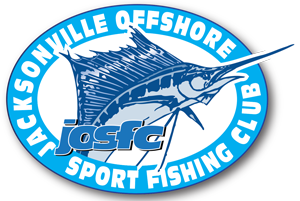The placement of Dry Dock AFDM-9 is probably one of the most unique artificial reefs ever developed by the Jacksonville Offshore Sport Fishing Club (JOSFC). Size alone places it in a category of one of the largest placements ever made, and by far the largest for the club to date. AFDM-9 was constructed in 1940’s and had an overall length of 608 feet. She was 124 feet in width and stood 57 feet from the keel to top of the wing walls.
I don’t recall exactly how I learned of the unit becoming available, but I think it was probably through our Artificial Reef Committee. Grover Starratt was Chairman of the committee at the time and was a main player throughout the entire project. In the process of running down leads, it became my pleasure to have met a true “Officer and a Gentleman.” Vice Admiral Richard Kennebrew, Ret. He depicted everything you ever heard or saw in movies about Naval Officers, or big ships, or the military. He became a key player in putting things together so that this placement could become a reality. I am grateful for his assistance on this project.
The AFDM-9 actually belonged to the Navy and had been on lease to one of the local ship yards for twenty years. The agreement stipulated the unit had to be returned to the Norfolk Shipyards upon completion of the lease. In order to make the return voyage in the open sea, the unit would have to be retrofitted at a cost of about 2 million dollars. The dry dock was old, somewhat out dated and probably wouldn’t fit the needs of the Navy’s modern fleet. To put a large amount of money into the vessel, just to tow it to Norfolk, seemed like a waste. I suggested to Admiral Kennebrew that he might want to consider donating the AFDM-9 to be used as an artificial reef.
This was the offer. The JOSFC would provide the necessary permits, and locate a suitable offshore area that was about 120 feet deep. This depth of water was needed to insure the vessel would have the required 50 feet of clearance after placement. In addition, the JOSFC would have the area surveyed to insure the unit would not be placed on any live bottom, and they would provide LORAN coordinates for the area of placement. The shipyard would prepare the unit to U.S.Coast Guard specifications, tow the dry dock to location and make the placement. All of this could be accomplished at fraction of the cost it would take to scrap the vessel or to have it retrofitted and returned to Norfolk. The Admiral agreed we went to work.
The following weekend Grover and I checked out an area about 45 miles Northeast of St. Augustine. Bob Engles had provided the LORAN numbers and suggested we look at this area because it would make the placement an equal distance between Jacksonville and St. Augustine. This way both communities would benefit from the placement.
The next order of business was to have the placement area surveyed. We called upon the expertise of the Reef Research Team of The Jacksonville Scubanauts to provide these services. They are an extremely capable and very technical group of individuals whose work is looked upon as being authoritative.
Admiral Kennebrew suggested that we contact Congressman Bennett. He had a lot of influence in Washington and could probably make things happen if we could sell him on the idea. Grover wrote to him and a short time later we had a one-on-one conversation with him in his Jacksonville office. It’s seldom you get the opportunity to ” sit-n-chat” with a Congressman of the stature of Charlie Bennett, it was a pleasure, very interesting, and he agreed to help with the project.
Everything was now working and all that remained was to let paper work and the slow wheels of bureaucracy turn to a completion. As it turned out, the vessel could not be donated to a private entity or, for that matter, even a public entity. It could only be donated to the State. Arrangements were made for the State to accept the vessel then turn it over to City of Jacksonville, who in turn guaranteed placement.
On September 13,1989, the giant dry dock AFDM-9, with four tugs at her side, left the St. Johns River for the last time. When they cleared the jetties two of the tugs returned to port. The remaining two continued on for another 45 miles to the Southeast and spotted the giant vessel above her final resting place. The equipment barge, which had accompanied the tow, was pulled along side the dry dock. The crew hurried to make ready all systems so the automatic valves that flood the bilge could be opened. Finally, the switches were engaged and within 30 minutes the giant vessel came to rest 120 feet below the surface of the Atlantic Ocean.
Before the last breath of air had finished leaking from her old seams, divers were descending to make an inspection and record the heading in which the vessel landed. Everything had gone as planned, it had landed flat on the keel line with the huge wing walls extending vertically toward the surface of the ocean. The placement was finally completed.
However, the forces of Mother Nature would take their toll. A later inspection revealed that the ground swells from hurricane David, which had passed near our coast, had collapsed one wing wall and rotated the huge vessel about 14 degrees from its original heading. Later, the effects of the devastating hurricane Hugo would collapse the one remaining wing. Today the vessel is one huge flat reef which measures approximately 180 feet in width, 608 feet in length and stands over 14 feet tall. This represents an area approximately the size of two foot ball fields placed side by side, which is a nice reef, a real nice reef.
In the past several years there have been reports of wahoo, tuna, sail cobia, king and even a white marlin being caught in the Dry Dock area. The area abounds with bait fish so you can also expect plenty of action from the barracuda.
With the average speed of the today’s recreational fishing boats, the run to the Dry Dock can be made in about an hour and half from either Jacksonville or St. Augustine depending on weather, of course. Another 10 miles to the East and you’re on the “Roll-Down” at the edge of the Gulf stream. Both areas can easily be fished on the same day. However, on long trips like these it goes without saying to check the weather conditions before starting out. This is the cardinal rule. Additionally you need to monitor the VHF weather channels during the day to keep yourself appraised of any changes .
“The Dry Dock,” a great place to fish, and a great achievement by the Jacksonville Offshore Sport Fishing Club.

